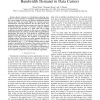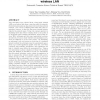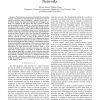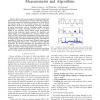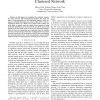INFOCOM
2011
IEEE
13 years 3 months ago
2011
IEEE
A simple random walk (SRW) has been considered as an effective forwarding method for many applications in wireless sensor networks (WSNs) due to its desirable properties. However...
INFOCOM
2011
IEEE
13 years 3 months ago
2011
IEEE
—Recent advances in virtualization technology have made it a common practice to consolidate virtual machines(VMs) into a fewer number of servers. An efficient consolidation sche...
INFOCOM
2011
IEEE
13 years 3 months ago
2011
IEEE
—In this paper we propose VIRO — a novel, virtual identifier (Id) routing paradigm for future networks. The objective is three-fold. First, VIRO directly addresses the challen...
INFOCOM
2011
IEEE
13 years 3 months ago
2011
IEEE
User association logs collected from a large-scale wireless LAN record where and when a user has used the network. Such information plays an important role in wireless network res...
INFOCOM
2011
IEEE
13 years 3 months ago
2011
IEEE
—In this paper we address the problem of scalable and load balanced routing for wireless sensor networks. Motivated by the analog of the continuous setting that geodesic routing ...
INFOCOM
2011
IEEE
13 years 3 months ago
2011
IEEE
—There has been recent interest within the networking research community to understand how performance scales in cognitive networks with overlapping n primary nodes and m seconda...
INFOCOM
2011
IEEE
13 years 3 months ago
2011
IEEE
—Recent advances in energy harvesting materials and ultra-low-power communications will soon enable the realization of networks composed of energy harvesting devices. These devic...
INFOCOM
2011
IEEE
13 years 3 months ago
2011
IEEE
—Target tracking is a main application of wireless sensor networks (WSNs), and has been studied widely [4], [10]. In this work, we study indoor passive tracking problem using WSN...
INFOCOM
2011
IEEE
13 years 3 months ago
2011
IEEE
Abstract—Network-coded cooperative communications (NCCC) is a new paradigm in wireless networks that employs network coding (NC) to improve the performance of CC. The core mechan...
INFOCOM
2011
IEEE
13 years 3 months ago
2011
IEEE
—In this paper, we investigate the multicast capacity for static network with heterogeneous clusters. We study the effect of heterogeneities on the achievable capacity from two a...

